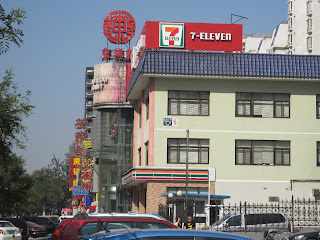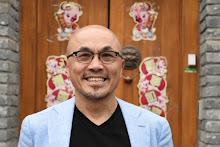Last Sunday, I went to Tongjiao temple to visit Vicky, a friend of my wife’s who regards herself as a devout or pious Buddhist. Vicky spends one morning a week volunteering her time at the temple. When I told her I wanted to interview her about Buddhism for the Traditional China class, she invited me to her temple to see where she volunteered and worshipped.
I went to the temple on bike and took some snapshots of my trip over. I live east of the East 3rd Ring Road, and the temple is located just inside the East 2nd Ring Road in the old city (the 2nd Ring Road marks the perimeter of Old Beijing), so my trip took me west. Here are some pictures of the traffic circle which marks the 2nd Ring Road.

It was a beautiful morning, and I saw two weddings on my route. One had an old fashioned wedding procession with dancing lions. The other was more of a modern day wedding with a limo waiting outside the restaurant.
There also some pictures of people getting ready for work -- restaurant workers lined up for the morning drill, chefs getting a last puff of their cigarette before heading back inside.
Some familiar signs....

This is the street the temple is on, and here is the main entrance to the temple which is under construction.

Below are pictures of the inner courtyard of the temple which was also under construction.

When I got to the temple, Vicky was waiting for me in the Bookstore (see left) where she was working that morning.
She was also responsible for taking donations from visitors. In the front of her desk, you can see two red donation boxes marked in Chinese, gongde xiang, which literally means Box of merits and virtues. Visitors can put donations in these boxes for the upkeep of the temple. They can also make donations for specific purposes (see the first podcast). I made a donation on behalf of Marist of 200 yuan (about U.S.$30) to save animals from being killed.
To the right is a sign that tells you not to speak, which Vicky explained really means not to engage in idle talk, but only chant Buddhist texts and talk about Buddhism. The volunteers at the temple were pretty good about ignoring this sign.
While I was talking to Vicky, various people would come through, some of them volunteers who -- yes, engaged in idle chatter -- others visitors, so you may hear talking in the background of the podcasts. One elderly gentleman who volunteered in the temple, had lived most of his life nearby and knew the history of the temple. He told me that there used to be 3 temples in this area, but two were torn down to make way for residential buildings. Of those two, one temple was for monks and the other was for nuns. Vicky explained that monks and nuns were segregated and could not live together in the same temple. The Tongjiao temple is for nuns.
To the right and below, you can see the nuns living quarters, and a room used to burn envelopes in memory of the dead.
The elderly man also told me that during the Maoist period, the Tongjiao temple was turned into a police station. He told me an interesting story of how police would detain suspected criminals in this temple, and every so often you'd walk in and see the police beating or kicking one of them. During this time, the main entrance which you see above was closed and only the side entrance (see below) was used. I took some pictures of the cars parked by the side entrance and you can see a number of police cars and vans from the police station which is relocated next to the temple. The temple was reopened for use in the early 1980s when the Communist Party allowed religion to be practiced again.

















